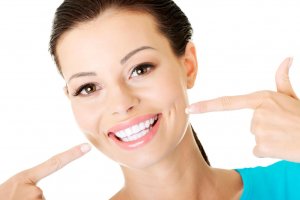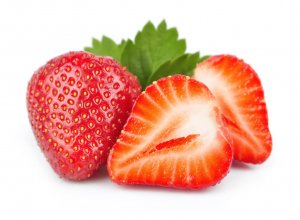Having a beautiful smile is something that many people dream of. Now, thanks to the availability of professional whitening and at-home teeth whitening kits, that dream is fast becoming a reality.
But just how safe is teeth whitening really? With the wealth of information across the internet – including numerous DIY whitening methods – there is currently a lot of misinformation floating around. From baking soda to lemons, it is vital to know the facts before you take whitening your teeth into your own hands.
Here is a quick breakdown of 6 of the most common misconceptions when it comes to getting whiter teeth.
In This Article
- 1 1. ‘Professional whitening gels and at-home whitening gels are the same.’
- 2 2. ‘Strawberries, lemons and baking soda can all be used to whiten your teeth.’
- 3 3. ‘Teeth can be whitened by using whitening toothpaste and whitening gum.’
- 4 4. ‘Crowns and veneers can be whitened as well.’
- 5 5. ‘Teeth stay white forever after being whitened once.’
- 6 6. ‘Only dentists can whiten teeth’
- 7 The bottom line
1. ‘Professional whitening gels and at-home whitening gels are the same.’

Professional whitening gels are stronger, and include a higher quantity of the active ingredient (i.e. the substance responsible for whitening the teeth).
That being said, the whitening gels that come with at-home kits can be nearly as effective as in-office whitening, nearly, of course, because of the lower active ingredient concentrations.
You wouldn’t necessarily want to use the same concentration of active ingredient at home as they do in professional settings, however. That’s because at the dentist, they have the tools needed to safely isolate your soft tissues, like your gums, lips and inner cheeks, ensuring they are fully protected from burning or irritation that could be caused by the whitening treatment.
With many kits, you can still manage to keep most of the gel off of your lips and gums, but there is still a risk it could happen, which is why it’s good to use a lower concentration gel if you’re on your own.
2. ‘Strawberries, lemons and baking soda can all be used to whiten your teeth.’

Strawberries and lemons may seem to whiten your teeth, because the acidity temporarily dehydrates your teeth, making them appear whiter for a short period of time. But once they are rehydrated, your teeth will go back to their original color.
In fact, the acidity and the corrosiveness of these fruits may even damage your enamel, which can make your teeth appear even yellower in the long run since the yellow dentin beneath your enamel will be more exposed.
You’ve probably heard baking soda mentioned as another natural whitening product. Although it’s true that baking soda is effective at removing surface stains, it won’t do anything to lighten the inner color of your teeth.
In fact, you could do more harm than good in the long run since it might disrupt the balance of good/bad bacteria in your mouth and excessive scrubbing can damage your tooth enamel.
If you want a natural way to whiten teeth, activated charcoal for teeth whitening sure is popular, but it isn’t likely to do anything except harm your enamel if you use it too much.
3. ‘Teeth can be whitened by using whitening toothpaste and whitening gum.’
Whitening gums and toothpastes are widely available but, unfortunately, they are unlikely to give you that Hollywood smile either. While it is true that they do contain whitening chemicals within them, the concentration will be much too low to have an effect. Whitening toothpastes should be considered a supplement to your teeth whitening routine.
4. ‘Crowns and veneers can be whitened as well.’
Whitening gels are designed for use on natural teeth only. They work by oxidizing the stains on your teeth, penetrating the tooth enamel to lift and remove intrinsic stains in the “pores” of tooth enamel.
Crowns and veneers, on the other hand, are made of porcelain, so this oxidizing mechanism does not work. As such, crowns and veneers would need to be replaced in order to color-match any newly whitened set of teeth.
5. ‘Teeth stay white forever after being whitened once.’
Unfortunately, as the teeth’s aging process continues, teeth darken and yellow again over time. Regular touch-ups are therefore required in order to maintain the level of whiteness, explaining why whitening teeth professionally, using customized molds, is the most highly recommended method.
6. ‘Only dentists can whiten teeth’

This is not true. In the United States, teeth whitening is not as regulated as in the UK and other countries. Whitening products are considered to be cosmetic rather than medical products so you may be able to find these services at your beauty salon. Despite such lax regulation, however, the FDA and ADA recommend consulting a dentist before committing to any whitening procedure.
Dentists are trained to know which whitening products are right to use for you and your teeth. This is because whitening gels contain a strong bleach (i.e. carbamide peroxide or hydrogen peroxide) within them. Only your dentist will be able to measure and decide the correct dosage required for each individual’s set of teeth.
Your smile is often the first thing that somebody will notice about you. Make sure that you keep it full and healthy by doing your research, and by consulting your dentist before using any ‘do-it-yourself’ options for whiter teeth.
The bottom line
To whiten teeth you need to use a product that has an active whitening ingredient, at a high enough concentration between 5% and 35% depending on ingredient and whether it is for at-home or in-office use.
Hydrogen peroxide and carbamide peroxide are the most common and most effective whitening solutions, but recent studies also show PAP to be just as effective for those who prefer to whiten teeth without peroxide.
ADA: ADA House of Delegates Whitening Report Consulted 21 May 2019
ScienceDirect: A bio-safetly tooth whitening gels composite with novel pthalamide peroxy caproic acid. Consulted 25 Jan 2024.




